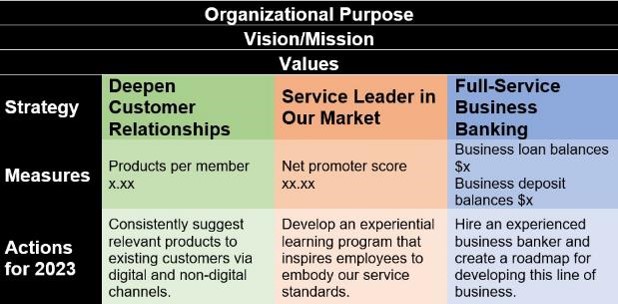3 minutes
These connections can help leaders gauge organizational progress toward its goals.
It can be a struggle for boards and other stakeholders to consistently connect their organization’s actions and measures of success to its strategy. Sometimes the strategy that was decided on during planning may become only tenuously connected to the measures of success and actions being taken as the year progresses. This can leave people feeling unsure about what is being done to achieve the strategy and whether the strategy is actually successful, even if everything is on track.
Ideally, an organization develops a high-level strategy, which then defines the measures and actions to be taken to support it. The right measures and actions are usually crystal clear coming out of planning but in practice, metrics are often reviewed on their own and their relationship to strategy can be lost. The same thing disconnect can happen with major projects or strategic actions undertaken to support the strategy.
Why Are You Measuring What You’re Measuring?
Most organizations have scorecards or key metrics tied to goals that are reviewed regularly to track success. A helpful exercise is to take a deeper dive to ensure everyone understands the purpose of each measure. Consider doing this each year to refresh memories and introduce any new measures that reflect fresh strategies. Ask such questions as:
- Why is this metric important? How does it connect to our strategy?
- If it’s not directly connected to our strategy, why are we tracking it? (e.g., general financial health)
- What does it mean and how is it calculated?
Measures are always an imperfect representation of what you’re actually trying to accomplish. Some things that are very important are also very hard to measure. So, getting clarity on the measures, especially the reasons behind them, is critical.
Create a Consistent Connection With Strategy
Reviewing scorecard measures or strategic actions on their own without relating them to strategy is like starting a book in the middle. Referencing the “whys” behind the measures and actions reminds everyone of those early chapters and tells a better story. For those steeped in implementing the strategy, the relationships may seem obvious, but building the habit of using the strategy for context can be very effective in bringing along those who are more peripherally involved. Keep in mind that:
- Even simple reminders of the connections to strategy during conversations about measures and actions can go a long way.
- The depth of detail should be appropriate for the audience. Boards typically would focus on the high-level scorecard and strategic-level actions. A department would drill down into departmental measures and projects.
- In written communication, an abbreviated version of the strategic plan containing only the key elements of the strategy is easier to remember and more likely to be read and referred to than a long and detailed version.
- Visual representations can also help people organize their minds around the elements of the strategy.
In this visual, stakeholders who know that strategic-level projects are underway but might be fuzzy on why they have been undertaken are provided the connection to the strategy at a glance. Measures are also put into the context of the strategy rather than being viewed as stand-alone.

Helping the board and other stakeholders maintain the connections between strategy, measures of success and actions is key to understanding true progress toward the strategy. An effective way to accelerate this is by intentionally creating habits that consistently put measures and actions into the context of strategy.
C. myers helps financial institution decision-makers uncover opportunities and continuously optimize their business models. Their depth and range of experience in linking strategy, talent, desired financial performance and successful execution enables them to work with their clients as strategic collaborators. They have the experience of working with over 600 financial institutions, including 200+ of those over $1 billion in assets. C. myers helps financial institutions think to differentiate and drive better decisions through strategic planning & business model optimization, strategic solutions and implementation, strategic leadership development, real-time ALM and financial forecasting, education, and thought leadership.





